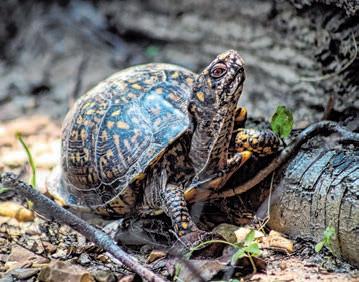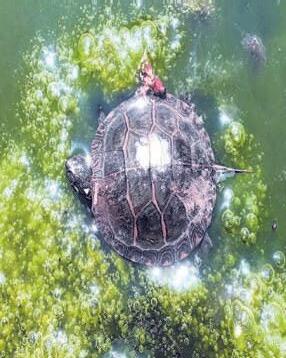
3 minute read
Why Did The Turtle Cross The Road?
Helping to preserve Long Island’s slowest reptiles
Amanda Olsen
Advertisement
aolsen@antonmediagroup.com


Late spring into mid-summer is the most common time to see Long Island’s turtles. Driving along through any wooded area, you might see something that looks like a rock on the road. There is a good chance, however, that that turtle-shaped rock is an actual turtle. That warm asphalt is especially appealing to these cold-blooded animals, and they often use the heat stored in the pavement to warm their bodies. Other reasons many turtles are spotted on the road at this time of year is because female turtles use soft, loose soil as nest sites, and because roads have fragmented their habitat. Turtles can take five to 20 years to reach sexual maturity and can live up to 80 years. Eggs are laid from late May to early July and incubate for two to three months.
The two most common types of native turtles seen here on Long Island’s roads are box turtles and painted turtles. Box turtles are the most terrestrial species, spending nearly their whole life out of the water. Their shell is domed and highlighted, and they are the only species able to completely close it. Males and females can be told apart by eye color - usually brown for females, red for males. Box turtles eat a variety of fleshy fruits such as strawberries and raspberries, other soft vegetation and mushrooms, worms, slugs and snails. They will also scavenge dead birds and mammals. These turtles are listed as special concern.

The painted turtle, New York’s most common turtle, is often seen basking in large groups near bodies of fresh water, disappearing into the water quickly when disturbed. Bright stripes on the neck and spots on the head can be seen when the turtle is basking.
The dark carapace is bordered with red and the plastron is plain yellow. Males have long claws on their front feet; females have longer shells. Painted turtles eat a variety of invertebrates, tadpoles and vegetation, but will also scavenge carrion.
Less commonly seen, but certainly still present, are snapping turtles. Easily recognized by its large head; long, saw-toothed tail; stocky legs with large claws; and the jagged, saw-toothed rear edge on its dark shell, the snapping turtle is New York’s largest freshwater turtle. This turtle will attack on land but prefers to flee into the water. This species is found in freshwater and brackish marshes, ponds, lakes, rivers and streams. Snappers often scavenge, but they also take live food, including small invertebrates to young waterfowl or small fish.
The other common turtle found in and around Long Island is the red eared slider. Red-eared sliders are invasive and are always the product of pet abandonment. It is illegal to release a pet-according to animallaw. info, “A person being the owner or possessor, or having charge or custody of an animal, who abandons such animal, or leaves it to die in a street, road or public place, or who allows such animal, if it becomes disabled, to lie in a public street, road or public place more than three hours after he receives notice that it is left disabled, is guilty of a misdemeanor, punishable by imprisonment for not more than one year, or by a fine of not more than one thousand dollars, or by both.”
These armored reptiles are unique among vertebrates because of their shells. The top part of the shell is called the carapace and the bottom part is called the plastron, which is also the name of the chest pad worn by fencers. While people have often repeated the old adage that turtles don’t feel anything through their shells, this is incorrect. They can feel every touch on that hard surface, which is made up of scales called scutes. A turtle’s spine runs along the inside of the shell, and they have nerves connecting this tough exterior to their nervous system. This is also why a turtle can’t survive without its shell. The shell is essential for defense from predators, but it doesn’t protect from fast moving vehicles or lawnmowers.
According to Hampton Turtle Rescue, the best way to help a healthy, uninjured turtle in the road or about to cross is to place them on the side of the road they were heading towards and watch to make sure they continue on their way. If placed in the direction from which they came, they will tirelessly attempt to head to the ingrained destination. Many of them have been taking this exact route for well decades and will not rest until they reach the location to which they are heading.
For snapping turtles, the fish and wildlife service recommends using a car mat or carefully holding them at the back of the shell and not the sides. Snapping turtles have very long necks and can bite your hands if you place them at the sides of the shell.
If you find an injured or distressed turtle, contact a licensed wildlife rehabilitator in your area. Do not remove the turtle unless asked to do so.


—With information from NYSDEC








